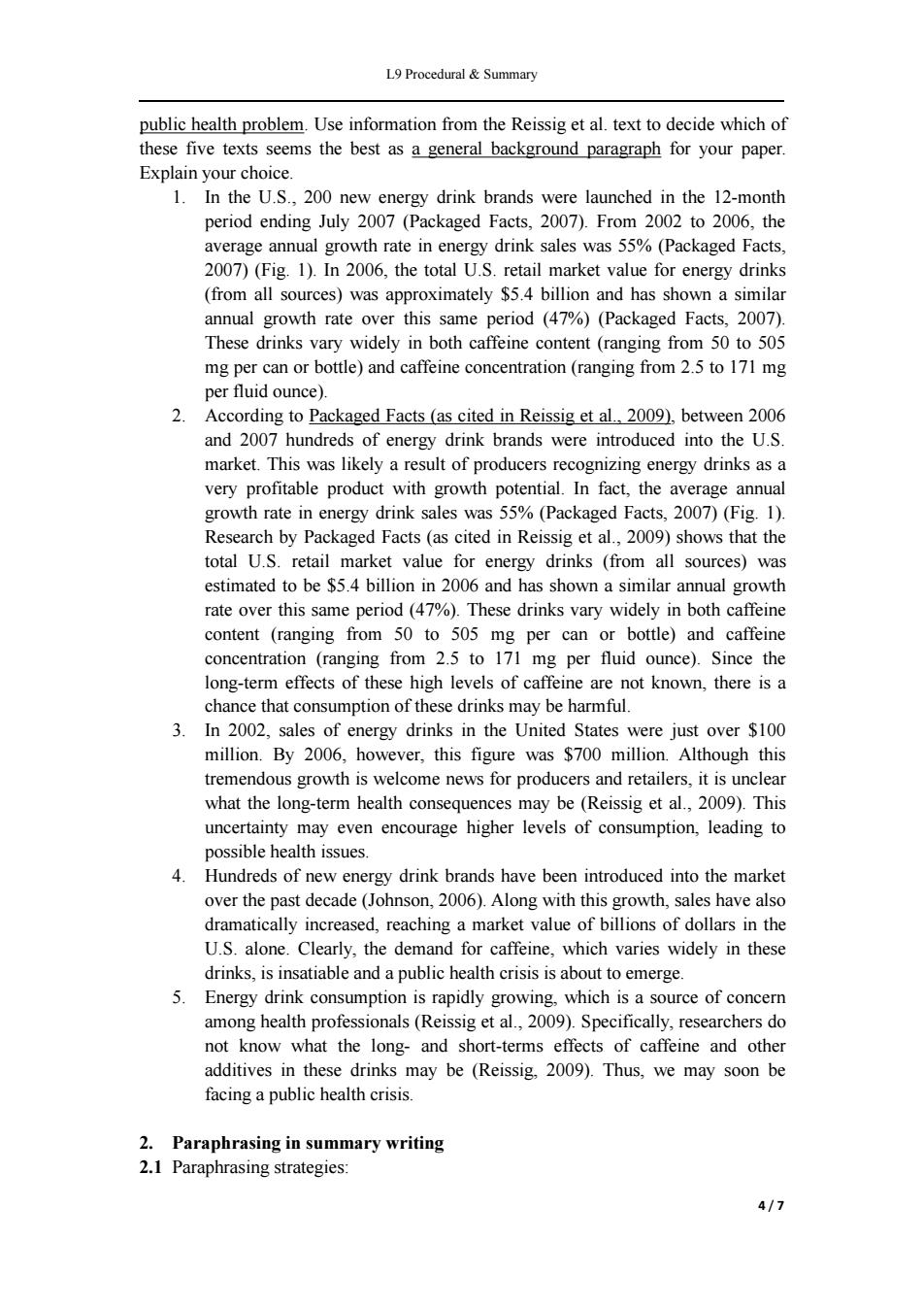正在加载图片...

L9 Procedural Summary public health problem.Use information from the Reissig et al.text to decide which of these five texts seems the best as a general background paragraph for your paper. Explain your choice. 1.In the U.S.,200 new energy drink brands were launched in the 12-month period ending July 2007(Packaged Facts,2007).From 2002 to 2006,the average annual growth rate in energy drink sales was 55%(Packaged Facts, 2007)(Fig.1).In 2006,the total U.S.retail market value for energy drinks (from all sources)was approximately $5.4 billion and has shown a similar annual growth rate over this same period (47%)(Packaged Facts,2007). These drinks vary widely in both caffeine content(ranging from 50 to 505 mg per can or bottle)and caffeine concentration (ranging from 2.5 to 171 mg per fluid ounce). 2. According to Packaged Facts (as cited in Reissig et al.,2009),between 2006 and 2007 hundreds of energy drink brands were introduced into the U.S. market.This was likely a result of producers recognizing energy drinks as a very profitable product with growth potential.In fact,the average annual growth rate in energy drink sales was 55%(Packaged Facts,2007)(Fig.1). Research by Packaged Facts(as cited in Reissig et al.,2009)shows that the total U.S.retail market value for energy drinks (from all sources)was estimated to be $5.4 billion in 2006 and has shown a similar annual growth rate over this same period (47%).These drinks vary widely in both caffeine content (ranging from 50 to 505 mg per can or bottle)and caffeine concentration (ranging from 2.5 to 171 mg per fluid ounce).Since the long-term effects of these high levels of caffeine are not known,there is a chance that consumption of these drinks may be harmful. 3. In 2002,sales of energy drinks in the United States were just over $100 million.By 2006,however,this figure was $700 million.Although this tremendous growth is welcome news for producers and retailers,it is unclear what the long-term health consequences may be (Reissig et al.,2009).This uncertainty may even encourage higher levels of consumption,leading to possible health issues. 4. Hundreds of new energy drink brands have been introduced into the market over the past decade (Johnson,2006).Along with this growth,sales have also dramatically increased,reaching a market value of billions of dollars in the U.S.alone.Clearly,the demand for caffeine,which varies widely in these drinks,is insatiable and a public health crisis is about to emerge. 5. Energy drink consumption is rapidly growing,which is a source of concern among health professionals(Reissig et al.,2009).Specifically,researchers do not know what the long-and short-terms effects of caffeine and other additives in these drinks may be (Reissig,2009).Thus,we may soon be facing a public health crisis. 2.Paraphrasing in summary writing 2.1 Paraphrasing strategies: 4/7L9 Procedural & Summary 4 / 7 public health problem. Use information from the Reissig et al. text to decide which of these five texts seems the best as a general background paragraph for your paper. Explain your choice. 1. In the U.S., 200 new energy drink brands were launched in the 12-month period ending July 2007 (Packaged Facts, 2007). From 2002 to 2006, the average annual growth rate in energy drink sales was 55% (Packaged Facts, 2007) (Fig. 1). In 2006, the total U.S. retail market value for energy drinks (from all sources) was approximately $5.4 billion and has shown a similar annual growth rate over this same period (47%) (Packaged Facts, 2007). These drinks vary widely in both caffeine content (ranging from 50 to 505 mg per can or bottle) and caffeine concentration (ranging from 2.5 to 171 mg per fluid ounce). 2. According to Packaged Facts (as cited in Reissig et al., 2009), between 2006 and 2007 hundreds of energy drink brands were introduced into the U.S. market. This was likely a result of producers recognizing energy drinks as a very profitable product with growth potential. In fact, the average annual growth rate in energy drink sales was 55% (Packaged Facts, 2007) (Fig. 1). Research by Packaged Facts (as cited in Reissig et al., 2009) shows that the total U.S. retail market value for energy drinks (from all sources) was estimated to be $5.4 billion in 2006 and has shown a similar annual growth rate over this same period (47%). These drinks vary widely in both caffeine content (ranging from 50 to 505 mg per can or bottle) and caffeine concentration (ranging from 2.5 to 171 mg per fluid ounce). Since the long-term effects of these high levels of caffeine are not known, there is a chance that consumption of these drinks may be harmful. 3. In 2002, sales of energy drinks in the United States were just over $100 million. By 2006, however, this figure was $700 million. Although this tremendous growth is welcome news for producers and retailers, it is unclear what the long-term health consequences may be (Reissig et al., 2009). This uncertainty may even encourage higher levels of consumption, leading to possible health issues. 4. Hundreds of new energy drink brands have been introduced into the market over the past decade (Johnson, 2006). Along with this growth, sales have also dramatically increased, reaching a market value of billions of dollars in the U.S. alone. Clearly, the demand for caffeine, which varies widely in these drinks, is insatiable and a public health crisis is about to emerge. 5. Energy drink consumption is rapidly growing, which is a source of concern among health professionals (Reissig et al., 2009). Specifically, researchers do not know what the long- and short-terms effects of caffeine and other additives in these drinks may be (Reissig, 2009). Thus, we may soon be facing a public health crisis. 2. Paraphrasing in summary writing 2.1 Paraphrasing strategies: